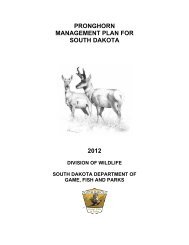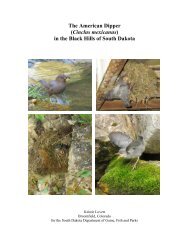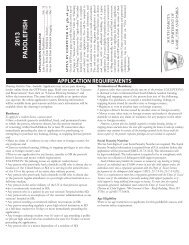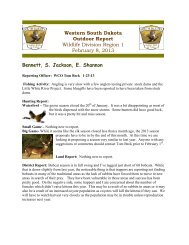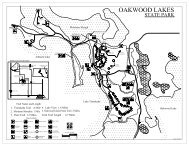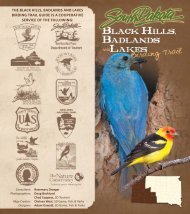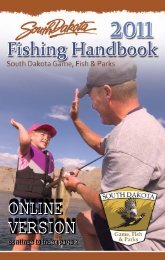pdf version - South Dakota Department of Game, Fish and Parks
pdf version - South Dakota Department of Game, Fish and Parks
pdf version - South Dakota Department of Game, Fish and Parks
You also want an ePaper? Increase the reach of your titles
YUMPU automatically turns print PDFs into web optimized ePapers that Google loves.
Largemouth Bass<br />
Micropterus salmoides<br />
Quick key characteristics: The largemouth bass is found in primarily warmwater<br />
habitats. Its scales are moderate in size. It has two, nearly separated dorsal<br />
fi ns, one (in front) with sharp spines instead <strong>of</strong> rays. It has one spine in each pelvic<br />
fi n, <strong>and</strong> three in the anal fi n. It has a very large, frontward-facing mouth, which<br />
extends beyond the rear margin <strong>of</strong> the eye in larger individuals, <strong>and</strong> a pointed<br />
snout <strong>and</strong> lower jaw projecting past the upper. Its body is taller than wide.<br />
Similar species in <strong>South</strong> <strong>Dakota</strong>: other bass, especially smallmouth bass<br />
Identifi cation: The combination <strong>of</strong> (1) a mouth extending beyond the rear margin<br />
<strong>of</strong> the eye, (2) a dark lateral (horizontal) stripe, (3) nearly separated dorsal fi ns,<br />
(4) larger cheek scales, <strong>and</strong> (5) a humped dorsal pr<strong>of</strong>i le between the snout <strong>and</strong><br />
fi rst dorsal fi n distinguishes the largemouth bass from the smallmouth bass.<br />
Range: The largemouth bass is native to southeastern North America, north<br />
to the Great Lakes <strong>and</strong> west to the Great Plains. In <strong>South</strong> <strong>Dakota</strong>, it is native<br />
to waters <strong>of</strong> the Minnesota <strong>and</strong> Big Sioux river basins, but has been widely<br />
introduced elsewhere. It is <strong>of</strong>ten abundant in ponds, lakes, <strong>and</strong> impoundments,<br />
particularly when protected from wind <strong>and</strong> containing submerged vegetation.<br />
Items <strong>of</strong> interest:<br />
• Feeds primarily on fi sh, crustaceans, <strong>and</strong> insects<br />
• Males construct nests <strong>and</strong> guard the<br />
eggs <strong>and</strong> hatchlings<br />
• Young-<strong>of</strong>-year have two distinct<br />
vertical b<strong>and</strong>s on the tail (caudal) fi n<br />
• Very popular sport fi sh <strong>and</strong> predator<br />
on insects, crayfi sh, <strong>and</strong> fi shes<br />
• May exceed 24 in. <strong>and</strong> 9 lbs.<br />
56








